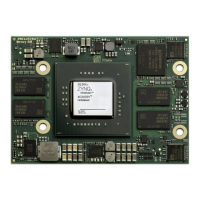3.7 eMMC Boot Mode
In the eMMC boot mode, the PS boots from the eMMC flash located on the module. The flash device is
connected to the PS MIO pins 13-22 for 8-bit data transfer mode.
3.8 QSPI Boot Mode
In the QSPI boot mode, the PS boots from the QSPI flash located on the module. The flash device is
connected to the PS MIO pins 0-5.
3.9 SD Card Boot Mode
In the SD card boot mode the PS boots from the SD card located on the base board. There are two SD card
boot modes available on the Mercury+ XU8 SoC module. Please note that the SD boot mode with level
shifter is currently not supported.
The SD boot mode with level shifter is used with Ultra High Speed (UHS) SD cards. The controller will start
the communication at 3.3 V and afterwards it will command the card to drop from 3.3 V operation to 1.8
V operation. For this mode, an external SD 3.0 compliant level shifter is required. This boot mode may be
supported in the future by Enclustra modules and base boards.
BOOT_MODE1 BOOT_MODE0 Description VCC_CFG_MIO
0 1 Boot from SD card (with an external SD 3.0
compliant level shifter; currently not sup-
ported)
1.8 V
1 1 Boot from SD card (default mode) Refer to Section 2.9.5
Table 39: SD Card Boot Modes
For the SD card boot mode, the following requirements must be met:
• The SD card must be connected to MIO pins 45-51
• A Zynq boot image must be generated from an MPSoC design having the SDIO controller enabled
• The boot image must be named “boot.bin” and then copied to the SD card
• The SDIO controller must be fed with a reasonable clock frequency. Please refer to the reference
design for guidelines on SDIO settings.
For details on SD card boot, please refer to the Zynq UltraScale+ MPSoC Technical Reference Manual [18].
3.10 eMMC Flash Programming
The eMMC flash can be formatted and/or programmed in u-boot or Linux, like a regular SD card. The boot
image or independent partition files can be transmitted via Ethernet or copied from another storage device.
Certain Xilinx tool versions support eMMC flash programming via JTAG.
3.11 QSPI Flash Programming via JTAG
The Xilinx Vivado and SDK software offer QSPI flash programming support via JTAG.
Certain Xilinx tools versions support QSPI flash programming via JTAG only when JTAG boot mode is used.
For more information, please refer to the Xilinx documentation [18] and support. Alternatively, the QSPI
flash can be programmed in u-boot or Linux by the SPI controller in the PS or from an SPI external master.
D-0000-454-001 49 / 60 Version 06, 18.11.2019

